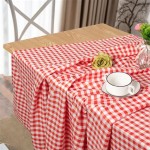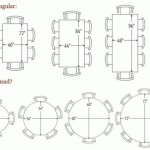Lazy Susan for Rectangular Dining Tables: Enhancing Accessibility and Aesthetics
The integration of a Lazy Susan into a dining table setup serves as a mechanism to improve accessibility and convenience during meals, especially in situations involving multiple diners and a variety of shared dishes. While frequently associated with round tables, the application of a Lazy Susan for rectangular dining tables presents unique considerations and advantages. This article explores the concept, design adaptations, benefits, and practical considerations associated with employing a Lazy Susan on a rectangular dining table.
A Lazy Susan, in its fundamental form, is a rotating tray or platform typically placed on a tabletop to facilitate the effortless sharing of food items. The rotational movement eliminates the need for diners to reach across the table, stretching, or requesting others to pass dishes, thereby promoting a more comfortable and equitable dining experience. Adapting this concept to rectangular tables, however, requires specific design considerations to maximize its utility and maintain aesthetic harmony.
The rectangular shape inherently presents challenges in achieving uniform accessibility compared to a round table. The longer sides of the rectangle necessitate a more strategically positioned or potentially elongated Lazy Susan to ensure that all diners, particularly those seated at the ends of the table, can easily reach the shared items. This often involves exploring different shapes and placements to find the optimal layout.
Key Point One: Design Adaptations for Rectangular Tables
The core design principle behind a Lazy Susan for a rectangular table revolves around optimizing reach and minimizing obstructed views. Several design adaptations can address these needs effectively. One common approach involves using an elongated, oval, or racetrack-shaped Lazy Susan. This shape allows the mechanism to span a significant portion of the table's length, bringing dishes closer to diners seated further away from the table's center. The degree of elongation needs to be carefully calibrated to the length and width of the table.
Another design option involves incorporating multiple smaller, circular or rectangular Lazy Susans strategically placed at intervals along the table. This approach requires careful planning to avoid overcrowding the tabletop and to ensure that each Lazy Susan serves a specific group of diners. The placement should be based on the typical seating arrangement and the types of dishes being served.
Instead of a single rotating platform, a modular system can be used. This involves several smaller rotating trays connected by a non-rotating frame or positioned independently. This offers flexibility in adjusting the configuration based on the number of diners and the specific meal being served. The modules can be easily rearranged or removed to adapt to different dining scenarios.
The material used in the construction of the Lazy Susan is another critical design element. Consider materials that complement the existing dining table and dining room decor. Common materials include wood (matching or contrasting the table's wood), glass (for a sleek, modern look), metal (for durability and a contemporary feel), and even stone (for a high-end, luxurious appearance). The material's weight contributes to the stability of the rotating platform and should be a factor in the decision-making process.
Furthermore, the height of the Lazy Susan is important. A lower profile Lazy Susan is less obtrusive and blends more seamlessly with the tabletop. However, a slightly elevated Lazy Susan, perhaps resting on short feet or a pedestal, can make it easier to access dishes without bumping into other items on the table. The optimal height depends on the height of the dishes typically served and the preferences of the diners.
Key Point Two: Benefits of Using a Lazy Susan on a Rectangular Table
The application of a Lazy Susan, specifically designed for rectangular tables, offers several distinct advantages that enhance the overall dining experience. First and foremost is improved accessibility. Diners no longer need to stretch awkwardly or request items to be passed across the table. This fosters a more relaxed and comfortable atmosphere, particularly during lengthy meals with numerous shared dishes.
Enhanced conversation and social interaction are another key benefit. By minimizing the need for physical reaching and passing, the Lazy Susan allows diners to maintain a more natural posture and engage more freely in conversation. It reduces interruptions and awkward moments, promoting a smoother and more enjoyable social experience during meals. The ability for everyone to reach dishes helps foster a sense of inclusivity and shared participation.
From a practical standpoint, a Lazy Susan can contribute to better table management and organization. By consolidating shared dishes onto a rotating platform, the available surface area is maximized, reducing clutter and preventing overcrowding. This helps to maintain a cleaner and more visually appealing tabletop throughout the meal. It also makes it easier to clear the table after the meal, as the shared dishes can be easily rotated to a central location for removal.
Moreover, a Lazy Susan can prevent spills and accidents. Instead of reaching across the table, diners can simply rotate the platform to bring the desired dish closer to them. This reduces the likelihood of knocking over glasses, bumping into other plates, or accidentally spilling food. This is particularly beneficial when dining with children or elderly individuals who may have limited reach or mobility.
Finally, a properly designed Lazy Susan can enhance the aesthetic appeal of the dining table. By selecting a material and design that complements the table and the surrounding decor, the Lazy Susan can become an integral part of the overall aesthetic. It can add a touch of elegance, sophistication, or modern flair, depending on the chosen style. It can transform a basic dining table into a focal point of the dining room.
Key Point Three: Practical Considerations and Implementation
Before integrating a Lazy Susan into a rectangular dining table setup, several practical considerations need to be addressed. The size and shape of the Lazy Susan should be carefully selected to match the dimensions of the table and the number of diners typically accommodated. Overly large Lazy Susans can dominate the tabletop and impede movement, while overly small ones may not adequately serve all diners. The Lazy Susan should leave sufficient space for individual place settings and other essential dining items.
The stability and weight capacity of the Lazy Susan are also important considerations. The base of the rotating platform should be sturdy enough to support the weight of the dishes commonly placed on it without wobbling or tipping over. The rotating mechanism should operate smoothly and quietly, without creating excessive noise or friction. Non-slip pads or feet can be added to the base to prevent the Lazy Susan from sliding on the tabletop.
The ease of cleaning and maintenance is another crucial factor. Choose materials that are easy to wipe clean and resistant to stains. Glass and smooth-finished woods are generally easier to maintain than textured or porous materials. Regularly cleaning the Lazy Susan will prevent the build-up of food residue and maintain its pristine appearance. Some designs may allow for easy disassembly for more thorough cleaning.
The placement of the Lazy Susan on the table is also critical. It should be positioned in a central location that is easily accessible to all diners. Avoid placing it too close to the edge of the table, as this can create an imbalance and increase the risk of tipping. The placement should also take into account the location of overhead lighting fixtures to prevent shadows from obstructing the visibility of the dishes.
Finally, consider the overall impact on the dining experience. While a Lazy Susan can greatly enhance accessibility and convenience, it is important to ensure that it does not detract from the overall aesthetic or impede conversation. The Lazy Susan should complement the existing decor and contribute to a more enjoyable and harmonious dining experience. It is essential to strike a balance between functionality and aesthetics to achieve the desired outcome.

Turn Your Table Into A Festival Of Organization With The Lazy Susan Turntable

Happy Dine Brown Lazy Susan For Rectangular Or Oval Dining Ubuy

Table Train Lazy Susan For Rectangular Welter S Co Ltd

Lazy Susan Table Guide Everything You Need To Know

Organize Your Space Effortlessly With Our Patented Lazy Susan Turntable For Rectangular Tables

What Size Lazy Susan Do I Need

Original Dark Gray The Lazy Susan Revolution Ubuy

Table Train Lazy Susan For Rectangular Welter S Co Ltd

Happy Dine Large Lazy Susan For Rectangular Or Oval Dining Tables Model Tto A Walmart Com

The Oval Lazy Susan








